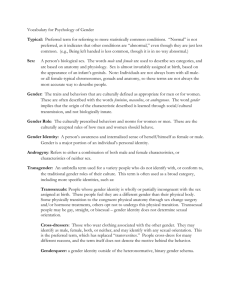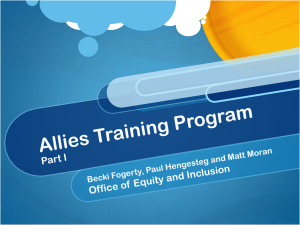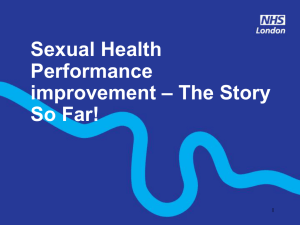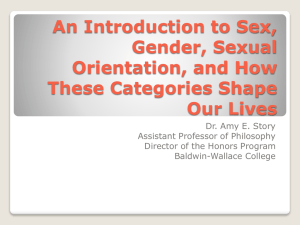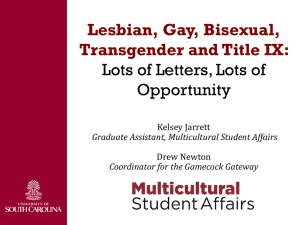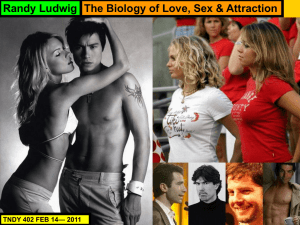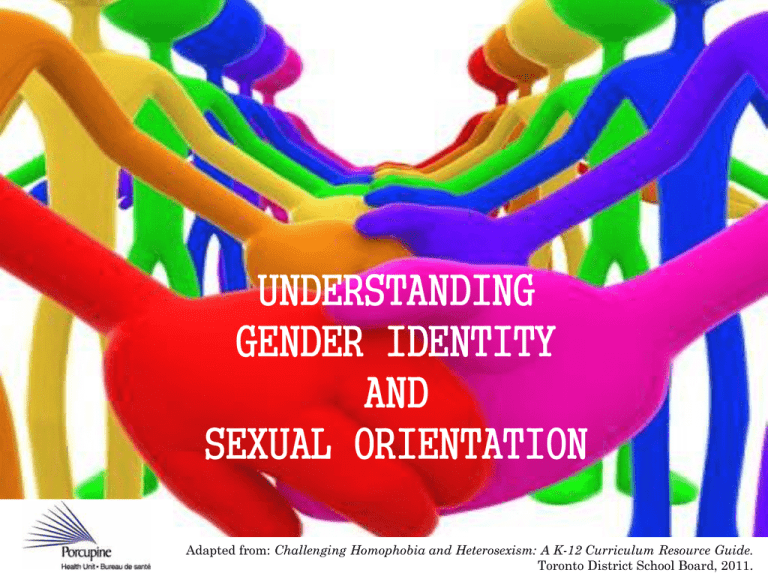
UNDERSTANDING
GENDER IDENTITY
AND
SEXUAL ORIENTATION
Adapted from: Challenging Homophobia and Heterosexism: A K-12 Curriculum Resource Guide.
Toronto District School Board, 2011.
DIVERSITY:
o Belief that differences among
people are accepted and
celebrated rather than viewed as
sources of separation.
INCLUSION:
o Belief that everyone, regardless
of race, culture, religion, gender,
language, disability, sexual
orientation, or any other
attribute is included as part of
the whole.
CANADIAN HUMAN RIGHTS ACT
(1985)
All individuals have an equal opportunity to
make for themselves the lives that they are able
and wish to have without being hindered or
prevented by discrimination based on:
o
o
o
o
o
o
Race
National or ethnic origin
Colour
Religion
Age
Sex
o
o
o
o
o
Sexual orientation
Marital status
Family status
Disability
Conviction that has been
pardoned
SEXUAL IDENTITY:
All living things appear in nature with a wide
range of naturally occurring variations. Humans
vary in skin colour, hair colour, height, etc.
Just as we would expect to see people with red
hair, blue eyes, or who are left-handed, it is also
normal to expect to see a wide range of diversity
with the spectrum of human sexual identity.
SEXUAL IDENTITY:
Studies are finding that our sexual identity is
developed from any number of influences before,
during, and after birth.
Four distinct and fluid characteristics shape
how we think about ourselves and how we relate
to others as sexual beings.
FOUR CHARACTERISTICS OF
SEXUAL IDENTITY:
Source: PFLAG Canada, 2009
BIOLOGICAL SEX:
Classification based on our anatomy or genetics.
Male
o
Intersex
Female
Biological sex is not always obvious and people
can be born with physical characteristics of
both sexes. These people are considered
intersex. Intersex conditions are not always
visible at birth and may not be noticed until
puberty (when hormones produce unexpected
changes) or during unrelated medical
procedures.
GENDER:
Describes the psychological and social meaning
added to being a man or woman.
Masculine
Feminine
IN OTHER WORDS. . .
Sex is what is between your
legs.
Gender is what is between
your ears.
GENDER ROLE:
The roles that men and women adopt.
It is a collection of attitudes and behaviours
that are considered normal and appropriate
in a specific culture for a particular sex.
It can also be defined as how we
communicate our gender to others.
GENDER IDENTITY:
One’s internal and psychological sense of
oneself as male or female, or both or neither,
regardless of sexual orientation. There are
some people who question their gender identity
and may feel unsure of their gender or believe
they are not of the same gender as their
biological sex or physical body.
TYPES OF GENDER IDENTITY:
Maleness/Masculine
Femaleness/Feminine
Two-Spirited- an Aboriginal term for an individual who
possesses both male and female spirits, and is thus
neither male nor female
Transgendered- a person who challenges strict gender
norms (may be transsexual, biologically Intersexed, etc.)
Third Gender- individuals who are categorized as neither
male nor female (by their own will or social consensus);
term also used in societies who recognize more than two
genders
Androgyny- a term that refers to a combination of masculine
and feminine characteristics
SOCIETIES WHO RECOGNIZE MORE
THAN 2 GENDERS?
North American First Nations Culture- “TwoSpirited” (translation of indigenous terms
denote “one who is transformed” or “one who
changes”
South Asian Culture- “Hijras” (physiological
males with feminine gender identity, roles)
Hawaiian/Polynesian Culture- “Mahu”
(biological male who takes on work and dress
of a woman)
GENDER IDENTITY IS NOT THE
SAME AS SEXUAL ORIENTATION:
Sexual
orientation is determined by a
pattern of romantic, sexual, and emotional
attractions felt by an individual toward
members of the same sex, the opposite sex,
or all sexes.
Who do you love?
Who are you attracted to?
Who do you care for?
TYPES OF SEXUAL ORIENTATION:
Heterosexual: attracted to individuals of the
opposite sex (straight)
Homosexual: attracted to individuals of the
same sex (gay, lesbian)
Bisexual: attracted to both sexes
Queer: attracted to the same or both sexes
and/or transgendered individuals
Asexual: not experiencing sexual attractions
ACTIVITY:
ASPECTS OF IDENTITYThese are the aspects of identity of a Grade 9 student.
1.
Which aspects can’t be chosen (e.g. born with)? And
which are things you can chose? Does the student
have the power to change certain aspects or not?
2.
Have you made any assumptions about the gender
or sexual identity of this student?
3.
How do you think this student would feel about
wanting to ask someone out on a date?
ACTIVITY:
ASPECTS OF IDENTITYNow open the small envelop included with your
student’s aspects of identity.
1.
How does his/her gender and sexual orientation or
gender identity affect your previous assumptions
about this student? Do you see your student
differently now?
2.
Out of all these aspects of identity, which would be
hidden or unknown to people unless they were told
about them?
3.
How do you think this student would feel in the
change room after gym class?
LGBT, LGBTQ, LGBTTQQI2SA. . .
L= Lesbian
G= Gay
B= Bisexual
T= Transgendered or
T= Transsexual
Q= Queer or
Q= Questioning
I= Intersex
2S= Two Spirited
A= Allies
TYPES OF DISCRIMINATION:
HOMOPHOBIA
Making generalizations (stereotyping)
and/or treating a person or a group
unfairly (discrimination) who are
though of as gay/lesbian or bisexual.
Also, it is an irrational fear, hatred or
repulsion of this group.
STATISTICS:
LGBT students hear anti-gay slurs an average of
26 times each day.
26% of LGBT youth are told to leave home.
LGBT youth are more likely to become homeless.
30% of all suicides are LGBT.
43% of trans-identified persons attempt suicide.
Source: PFLAG Canada, 2009
TYPES OF DISCRIMINATION:
HETEROSEXISM
The belief or assumption that
everyone is heterosexual and that
heterosexuality is the only “right” and
“natural” sexual orientation
Heterosexuality is superior to
homosexuality
It results in the invisibility of anyone
who doesn’t fit into the heterosexual
norm
EXAMPLE OF HETEROSEXISM:
Imagine if you lived in a society which, for
the most part, pretended that you and people
like you did not exist. . . where newspapers,
books, films, television, radio, the education
system, and hospital services all failed to
acknowledge your existence or else defined it in
a condemnatory and bigoted way. How would
you feel?
Source: STANCE Against Homophobic Bullying, 2007
HETEROSEXUAL PRIVILEGE:
Privilege refers to something that you have not
necessarily earned.
Heterosexual privilege means that individuals
who are heterosexual automatically gain some
rights and advantages simply because they are
attracted to individuals of the opposite sex.
Heterosexual privilege may also refer to the
benefits that LGBT gain by claiming a
heterosexual identity.
Is this RIGHT??
FINAL THOUGHTS. . .
As a heterosexual, how would you feel if you:
o
o
o
o
o
Had to live a secret life?
Had to live in fear of being found out and at the
mercy of other people’s prejudice?
Had to read in the media that that young people
should be protected from learning about your
“unsatisfactory” lifestyle?
Had to read/listen to people discussing the
“causes” of your “problem” behaviour and how it
could be cured?
Could not protest about this for fear of identifying
yourself and losing your job or even your children?
Source: STANCE Against Homophobic Bullying, 2007

